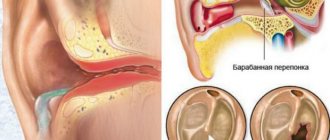General symptoms of sore throat
We are all accustomed to the fact that developing tonsillitis, as inflammation of the tonsils or sore throat is called in medical terminology, causes a sharp deterioration in a person’s condition.
Patients develop several distinct specific signs:
- general weakness, headaches, runny nose;
- high body temperature, often reaching critical levels of 39-40 °C;
- severe and sharp pain in the throat, aggravated by any swallowing movement;
- enlargement and tenderness of the cervical lymph nodes located under the lower jaw.
Manifestations of sore throat without fever
For young children who develop a sore throat, in addition to the above symptoms, pathological phenomena such as ear pain, excessive drooling and loss of appetite are also characteristic. As can be seen from the listed symptoms, the familiar inflammatory process that affects the throat is accompanied by fever, but experts often hear from patients the question of whether there can be a sore throat without fever. The answer to this, oddly enough, is positive.
The absence of this symptom in a person with tonsillitis, as otolaryngologists explain, is associated with a minimal number of microorganisms affecting the throat and an adequate immune response. To put it simply, the absence of fever during inflammation of the tonsils is not a separate type of disease, but a milder course of tonsillitis developing in the patient. With this form of the disease, the inflammatory process is superficial, but if timely treatment is not started, it will become deeper and more extensive, which will provoke the appearance of fever.
Symptoms of sore throat without fever
With a mild course of the pathological process, negative symptoms are practically not expressed. A person in whose tonsils a pathological process begins to develop may simply not pay attention to dryness and a slight sore throat or mild headaches. Such ignoring of the disease leads to the development of more serious forms of tonsillitis.
To prevent this, otolaryngologists recommend seeking advice from a specialist if the following warning signs appear, even if they are barely noticeable:
- general weakness;
- minor headaches;
- redness and swelling of the tonsils;
- sore throat and pain when swallowing;
- slight swelling of the cervical and submandibular lymph nodes.
The listed symptoms of a sore throat without fever are almost completely similar to the manifestations of ordinary tonsillitis with fever. In rare cases, there is a slight increase in body temperature, but it is so minimal, not higher than 37.5°C, that the person does not feel it.
Worth knowing! Most often, a sore throat without fever develops in preschool children. Parents of these babies should be more attentive to the general well-being of the child and be sure to show him to the pediatrician if there is a loss of appetite and interest in favorite games, the appearance of lethargy, and the presence of redness and swelling in the throat area. If the onset of the disease is noticed on time, it will not develop into a more severe form and will not cause serious health problems for the child.
Danger of the disease for pregnant women
Sore throat can affect anyone, regardless of age and gender. During pregnancy, the risk of developing this disease increases significantly, which is facilitated by weakening of the body and hormonal imbalance. The disease at this time is dangerous both for the development of the child and for the woman herself.
The first trimester of pregnancy is the most favorable period for sore throat. It is at this time that a real hormonal revolution begins, metabolic processes change, toxicosis and psychological stress arise, and the woman’s body has not yet had time to adapt to new conditions. A woman visits medical institutions more often, where the likelihood of meeting a carrier of the infection is much higher.
The infection cannot directly affect the embryo. The danger comes from toxins released by the pathogen and entering the woman’s blood. The development of the disease causes hypoxia, creating a deficiency of oxygen and nutrients. In the first days after conception, toxins can cause the death of a fertilized egg. In the future, there is a possibility of primary placental insufficiency as a result of improper formation of the placenta.
The progression of the disease can lead to secondary failure, which is manifested by fetal hypoxia, slowing down its development, and sometimes results in premature birth and other pregnancy complications. It is in the 1st trimester that toxins can form birth defects, for example:
- hydrocephalus due to impaired brain development;
- intracranial calcification;
- heart defects;
- limb defects.
The 2nd trimester of pregnancy is characterized by frequent exacerbation of sore throat in the form of placental insufficiency. At this stage, the slowdown in fetal growth and development is often due to a deterioration in the supply of oxygen and nutrients to the fetus. In the 2nd trimester, sore throat is most dangerous for the child. Under the influence of infection, a violation of eye formation is recorded. Congenital liver defects and an enlarged spleen appear. During pregnancy, polyhydramnios may occur. With sore throat and other infections, as well as when a complex of unfavorable factors appears, there is a risk of spontaneous abortion.
In the 3rd trimester, the influence of sore throat is less dangerous, given that the female body has fully adapted and acquired the necessary protection, and most of the child’s organs are formed and less susceptible to infection. However, the danger of angina during this period cannot be underestimated. It is possible to develop fetoplacental insufficiency, leading to defective development of the child and premature birth. If in the 2nd trimester the child suffers more from sore throat, then in the 3rd trimester the disease becomes more dangerous for the woman herself: peritonsillar abscess, otitis media, sinusitis and other pathologies. In the future, complications may include cardiac problems, kidney diseases, and joint diseases.
Types and forms of sore throats that occur without fever
Quite often, people with nasopharyngeal problems and a history of diseases such as ethmoiditis, sinusitis, sinusitis, which provoke the accumulation of pus, are exposed to unilateral inflammation of the tonsils, which occurs without fever. They usually develop bacterial tonsillitis without fever. A person’s predisposition plays an important role. Some people, having barely gotten their feet wet, get tonsillitis, and some, on the contrary, can walk in the cold in light shoes and not know what inflammation of the tonsils is.
In people susceptible to this disease, sore throat without fever can be of several types:
- Catarrhal, viral tonsillitis. The mildest form of tonsillitis, most often occurring as a complication of an infectious disease caused by viruses. This type of disease is never accompanied by fever, since the inflammatory process affects only the surface of the tonsils, without penetrating deep into the tissues.
- Follicular tonsillitis. Without fever, the disease occurs only in the first 2-3 days, when pustules just appear on the surface of the tonsils, affecting the follicles, the main structural elements of the tonsils. If the course of the disease is prolonged or the patient violates the therapeutic course, he develops lacunar tonsillitis, almost always accompanied by a febrile state. Its course without an increase in temperature is considered very rare in clinical practice.
- Purulent sore throat without fever. This form of the disease is the least common and is typical mainly for young children. In addition, it is considered the most dangerous, because the bacteria that provoke this form of the disease are easily transmitted by airborne droplets and the disease quickly becomes widespread.
- Ulcerative-membranous. The only form of the disease that occurs completely without fever, although all other signs of tonsillitis are pronounced.
These ENT diseases, associated with the inflammatory process in the tonsils and occurring without an increase in temperature, are the most dangerous, since the body in this case fights infection much worse. Tonsillitis without fever does not cause concern in a person, so the patient is in no hurry to visit a doctor, which provokes a worsening of the condition and the development of serious complications.
Types of sore throat and their symptoms
When infected, the body expends energy to increase the supply of nutrients and vitamins to the fetus through the placenta, which is why many pregnant women initially have tonsillitis without fever. The causative agents are group A streptococcus, staphylococcus, pneumococcus, fungi and Haemophilus influenzae; infection occurs through airborne droplets and household contact.
The symptoms of the pathology are similar to acute respiratory viral infections and the flu - the woman feels a sore throat, general weakness, and aching muscles.
As the symptoms progress, they become more pronounced and depend on the type of sore throat:
- catarrhal - this form is considered the easiest. The tonsils are affected superficially, the temperature rises slightly, general health may not be affected. If you do not start treatment, the disease goes away on its own or progresses to the following stages;
- follicular – inflammation affects the follicles of the tonsils. The throat is swollen, purulent patches are visible through the mucous membrane. The contents are released from the follicles and accumulate on the surface of the tonsils. The temperature reaches 38-39oC;
- lacunar – has a severe course, the thermometer rises to 39-40°C. Pus accumulates in the lacunae of the tonsils; they look like wide white-yellow furrows. Pathological plaque spreads over the entire surface of the larynx;
- ulcerative-necrotic - the most severe form of tonsillitis. The tonsils become covered with a dark green coating, and after it is cleansed, bleeding ulcers remain on the mucous membrane. The condition worsens sharply, aggravated by vomiting, high fever, and impaired consciousness.
Carefully! Purulent sore throat is most dangerous for the expectant mother and baby, since bacterial agents can penetrate through the general bloodstream to the fetus and cause infection. Therapy should be started at the initial, catarrhal stage, when antibiotics can be dispensed with and serious consequences can be prevented.
Diagnosis of sore throat without fever
In order for a specialist to make the correct diagnosis for tonsillitis that occurs without fever, he needs to conduct a clinical and laboratory examination of the patient. Their results will give the specialist the opportunity to select the right course of therapeutic measures to cure a sore throat in the shortest possible time. The clinical examination consists of interviewing the patient and an initial examination, consisting of palpation of the submandibular, parotid and cervical lymph nodes. The doctor also examines the oropharynx.
After all the manipulations have been carried out, he makes a preliminary diagnosis and refers the person to clarifying laboratory tests, which consist of the following activities:
- General blood test. An increased level of leukocytes directly indicates developing inflammation.
- Bacteriological method. A scraping from the tonsils is taken from the patient and examined under a microscope to identify pathogenic microorganisms that provoked the inflammatory process.
Only after the pathogenic microorganism that caused the sore throat is identified, therapeutic measures are prescribed to the patient.
Treatment of sore throat during pregnancy
It is important to clearly know how to treat sore throat during pregnancy. First of all, adherence to strict bed rest and drinking plenty of fluids.
The food should be soft so as not to injure the already inflamed mucous membrane of the tonsils.
Due to the fact that most medications prescribed for sore throat are contraindicated during pregnancy, treatment of sore throat in pregnant women is somewhat different from traditional therapy.
Treatment of tonsillitis in the first trimester
In the first 3 months, the embryo develops the heart, blood vessels, digestive organs, and nervous system.
During this period, if a sore throat is detected during pregnancy, treatment is complicated by the fact that many medications cannot be taken due to the risk of harming the developing fetus.
Antibiotics are prescribed of a certain type, harmless to the baby, but after passing an analysis to determine the type of virus and its sensitivity to antibacterial drugs.
It is important to remember that you should not stop using the antibiotic when improvement occurs for fear of harming the child.
The course must be completed to kill all germs. Otherwise, harmful microorganisms develop resistance to the drug.
Treatment can be carried out at home. It should consist of the following aspects:
- strict bed rest;
- the diet should be dominated by foods containing proteins and vitamin C;
- drink plenty of fluids (at least 100 g of warm water per hour) - tea with honey and lemon, juices, dried fruit compote, still warm mineral water. Chicken broth is very useful during this period, as it saturates the stomach and at the same time replenishes fluid loss;
- relieve fever without using medications - wipe with warm water, apply cold compresses to the forehead, wash your face with cool water; only Panadol and Paracetamol are antipyretics;
- 4-5 times a day, gargle with a decoction of chamomile or sage, or a soda-salt solution;
- inhalation with a decoction of chamomile and sage, mint, pine buds, potatoes, but take with caution for no more than 3-4 minutes.
Treatment of sore throat in the 2nd trimester
Sore throat during pregnancy in the second trimester is treated with the same methods as indicated above. The 2nd trimester of fetal development makes it possible to use drugs with local effects directly on the affected areas.
These drugs include Furacilin, Antiangin.
Furacilin is the safest and most effective medicine with antibacterial, antiseptic and regenerating effects.
Rinsing with Furacilin solution for 5-6 days completely kills pathogenic microorganisms (add 2 powdered Furacilin tablets to 1 glass of hot water until completely dissolved, rinse for 4 minutes every 3-4 hours).
However, this remedy in rare cases has side effects - allergies, nausea and vomiting, dizziness, bleeding.
Antiangin lozenges have a good antimicrobial and analgesic effect.
The antiseptic Chlorhexidine contained in the drug destroys the viruses of pneumococci, staphylococci and streptococci. The effect is felt a few minutes after administration.
Therapy for tonsillitis in the 3rd trimester
Treatment of sore throat in pregnant women in the third trimester is much easier to treat, since almost all organs of the fetus are already formed.
But the 3rd trimester of pregnancy when infected with viruses is dangerous because the disease can lead to the development of a weakening of labor.
Inflammatory processes of the mucous tonsils in the last stages are treated as follows:
- antibiotics are prescribed (Penicillin, Erythromycin, Sumamed, Gentamicin);
- local antiseptics - Anti-angina;
- gargling and inhalation with pharmaceutical herbs, with the addition of fir, eucalyptus oil, soda-saline solution, Furacilin, Miramistin;
- diet therapy - foods high in various vitamins, irritating foods - salty, spicy, sour - are excluded.
- To flush out toxins from the body, drink plenty of fluids.
How to treat a sore throat without fever in children and adults?
Tonsillitis not accompanied by fever requires qualified, timely treatment. Moreover, therapeutic techniques are similar for all forms of this disease. The main treatment for sore throat without fever is the use of antibacterial drugs. Prescribing antibiotics almost always helps to get rid of the root cause of the disease and achieve a speedy recovery for the patient. Most often, for an inflammatory process in the throat that occurs without fever, the sick person is prescribed Ampicillin and Amoxicillin.
A sore throat without fever in an adult can be cured fairly quickly using these remedies. But we should not forget that the dosages of drugs are selected strictly individually. This avoids side effects. When a child has a sore throat, Flemoxin is prescribed. This is a strong antibacterial drug of the penicillin series, which has a gentle effect on the digestive tract. The dosage of tablets is selected exclusively by the attending physician, depending on the age and weight of the baby.
In addition to antibacterial therapy, patients are prescribed a number of additional measures:
The main difference between the drug treatment of tonsillitis, which occurs without fever, and other forms of inflammation of the tonsils, is the absence of antipyretic drugs in therapeutic prescriptions. To get rid of the disease and prevent the development of complications or infection of loved ones, it is necessary to strictly follow all the recommendations of the attending physician and avoid errors in taking the medications prescribed by him.
Treatment of sore throat using traditional methods
Self-therapy is strictly prohibited, since the majority of drugs against angina are included in the group of contraindications.
Antibacterial therapy. Antibacterial agents are always used against bacteria, but they must be included in the group of drugs whose use is acceptable during pregnancy. Most often, a pregnant woman is prescribed a penicillin group of antibiotics: Amoxicillin, Phenoxymethylpenicillin, Amoxiclav, Ampicillin. It is also possible to use cephalosporins: Cefaclor, Cephalexin, Cefepime, Cefotaxime. Macrolide antibiotics (Azithromycin) are sometimes prescribed, especially if you are allergic to penicillin. But for very severe purulent lesions, carbapenems (Meropenem) are used. All antibacterial drugs are strictly prescribed by the attending doctor, who determines the dosage and course of therapy.
You should not reduce the dosage or shorten the course of treatment, because it is not the sore throat itself that is scary, but the complications that it leads to if it is treated incorrectly or untimely. Usually the course of treatment is at least 7 days, most often 10 days. Azithromycin and its analogues are prescribed for 5-7 days.
Antiseptic treatment. During treatment, in addition to antibiotics, antiseptic agents are also prescribed, as they neutralize unpleasant symptoms. Solutions for rinsing and inhalation are used for local effects on the oropharynx. There are medications in spray form.
Frequently used means:
- Furacilin solution. Making a solution from tablets is simple: pour 2 pre-crushed tablets with a glass of boiling water, thoroughly dissolve the resulting Furacilin powder. A rinse solution is used.
- Chlorhexidine solution. It is sold in various concentrations: 0.05, 0.2, 0.5. In the first case, gargle without diluting with water. In the other 2 the ratio is 1:4, 1:10.
- Miramistin spray has a convenient nozzle. Designed to irrigate the throat.
- Inhalipt is available in the form of a spray. Additionally, it has an analgesic effect. Based on thymol, mint, eucalyptus.
- Chlorophyllipt solution is made from eucalyptus. It is produced in a solution for gargling, dissolving tablets and an oil-based solution. The tonsils are the last to be lubricated.
After eating, be sure to gargle.
Other means:
- To reduce body temperature and relieve pain, the doctor will prescribe Paracetamol.
- Approved lozenges and sprays: Decathylene, Strepsils, Stopangin, Givalex.
- Inhalations can be done using eucalyptus oil. The oil is added to the main inhalation solution. Do not use a nebulizer.
Without antibiotic treatment, a sore throat will go away on its own within a week. Antibiotics are taken to stop the infection and prevent the development of complications in various organs of the patient, the risk of which without treatment is very high.
Mandatory activities:
- Meals should be according to appetite, and dishes should be pureed or liquid (broths, pureed soups, vegetable and meat purees, homemade pates).
- Drinking should be plentiful (you can drink jelly, tea, compote, alkaline-salt mineral water). If cold drinks are easier to swallow, drink them.
- Maintain bed rest, especially at very high temperatures.
Rubbing with vinegar and alcohol, taking cold baths, and taking Aspirin are prohibited. All these activities have a negative impact on the unborn child.
How to treat a sore throat without fever in pregnant women?
For a woman carrying a child, such a phenomenon as inflammation of the tonsils without an increase in body temperature is far from uncommon. The worst is considered to be follicular tonsillitis in pregnant women, which occurs without an increase in temperature. Bacteria that infect a woman’s throat very quickly enter the bloodstream and spread throughout the body. As a result, intrauterine abnormalities may occur in the development of the fetus, and there is also a threat of premature birth. In order not to harm the unborn baby, a woman must properly treat a sore throat. An integrated approach is required in therapeutic activities.
During pregnancy, the following treatment methods are prescribed:
- Antibacterial therapy. Only the attending physician should prescribe medicine to the expectant mother, depending on the type of sore throat. Among the drugs allowed during pregnancy and effective, experts note Gentamicin, Sumamed, Erythromycin, Penicillin.
- Gargling. This procedure should be performed as often as possible. The most effective antiseptic solutions based on furatsilin, salt and soda.
- Inhalations. The procedure performed with herbal decoctions of sage or chamomile shows a good effect. But you should be very careful with inhalations during pregnancy and not carry them out without first consulting your doctor.
- Local effects on the sore throat with Stopangin or Givalex sprays, as well as the resorption of Decatylene or Strepsils tablets that soften the inflamed larynx.
Important! It is strictly not recommended to treat a sore throat in the early stages of pregnancy, which occurs without fever, using traditional methods. The most dangerous thing is to warm your feet, since this action is ineffective for sore throat and, moreover, can provoke uterine tone and, as a result, the threat of miscarriage.
Peculiarities
Before prescribing therapy for sore throat during the second trimester of pregnancy, it is necessary to find out what form of it has affected the woman’s body. There are bacterial and catarrhal purulent forms of the disease. It is necessary to consider purulent sore throat during pregnancy very carefully. It comes in the following types:
- lacunar - the formation of a yellowish film on the tonsils;
- follicular – white pustules are present;
- necrotic - accompanied by death of the tonsils.
How a sore throat is treated with Bioparox can be found in this article.
Taking into account all the varieties of this pathology, its treatment in expectant mothers should involve determining the form of sore throat. Only then will the prescribed therapy give a positive result. Self-medication is prohibited.
The video talks about the treatment of sore throat during pregnancy in the second trimester:
Prevention of tonsillitis
To prevent the development of inflammation of the tonsils, it is necessary to follow the rules of a healthy lifestyle.
They are quite simple and known to everyone:
- Strengthen the immune system through an active lifestyle, daily walks in the fresh air and regular exercise.
- Maintaining oral hygiene and regular sanitation (at least once every six months). These actions will prevent the proliferation of pathogenic bacteria.
- Air and water hardening. This method of preventing sore throats is considered the most effective.
- Maintain slightly humidified air in the living room and regularly ventilate it.
- Timely and complete treatment of otolaryngological diseases.
- Trips, if possible, to the sea coast.
In addition, in order not to miss the development of a pathological condition, you should not neglect free medical examinations, and you also need to visit a doctor regularly during epidemics of infectious diseases. This will help to promptly identify the development of the inflammatory process.










